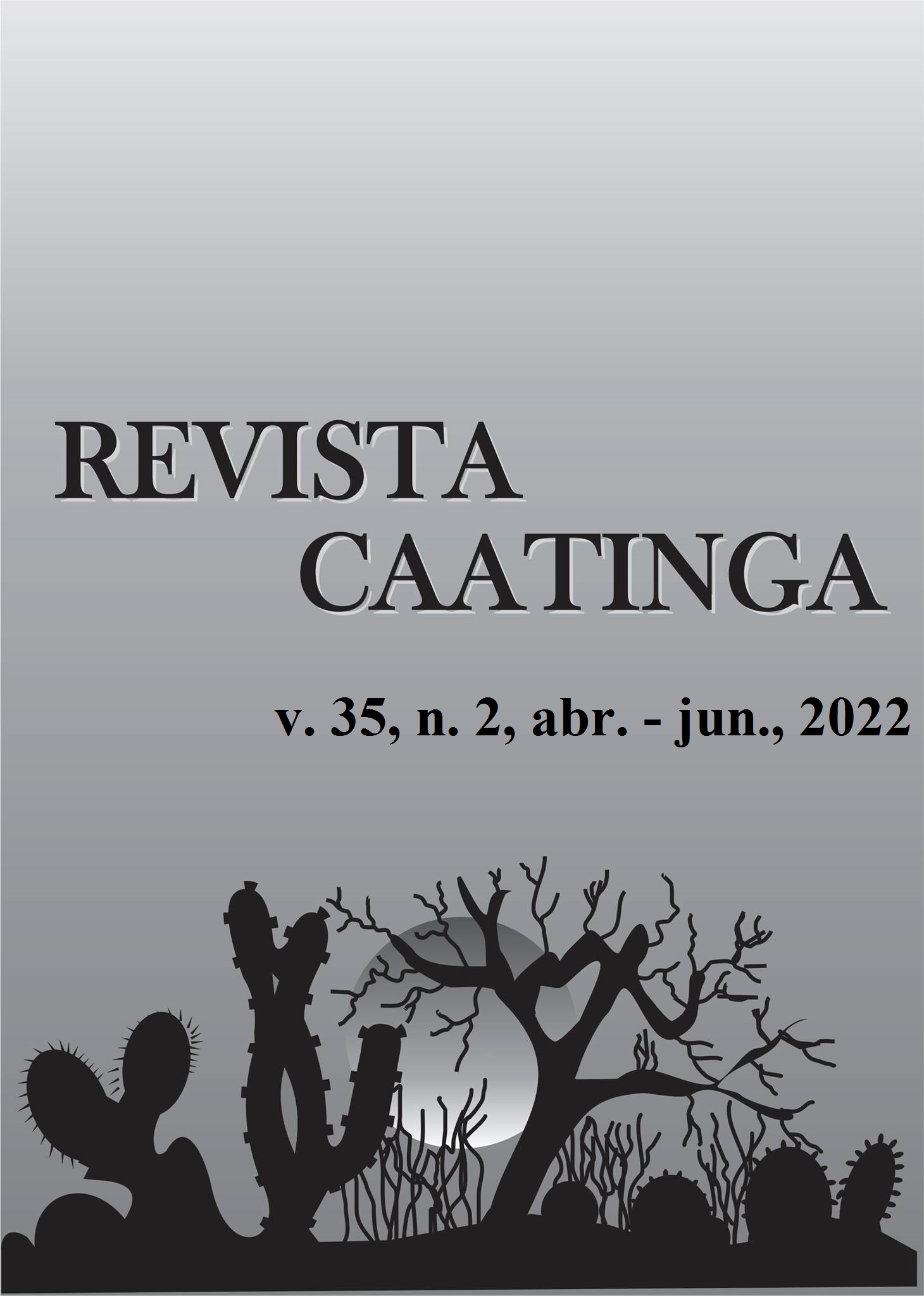COMBINING ABILITY AND GENE ACTION IN THE EXPRESSION TRAITS IN MAXIXE
DOI:
https://doi.org/10.1590/1983-21252022v35n225rcKeywords:
Cucumis anguria L. Heterosis. Crossing.Abstract
The gherkin (Cucumis anguria L.) is a species of African origin, belonging to the family of cucurbits, widely cultivated in Brazil, but with little information on the genetic control of the characteristics. Additive gene effects, reflected in estimates of variety or performance effects “per se,” are important in the expression of traits in maxixe genotypes. The objective of this study was to estimate the combinatorial capacity and the gene effect in gherkin genotypes. Two experiments were conducted in 2 years in a randomized block design with three replications. The treatments were nine parents of gherkin and their hybrid combinations obtained in a diallel cross. Varietal heterotic expression as the greatest in the characteristics of fruit diameter, average weight, and firmness of the fruit pulp. In gherkin genotypes, the largest deviations due to non-additive gene effects were in the characteristics of fruit diameter, length, and yield. In general, the crosses that had commercial genotypes as parents, presented high average estimates, associated in some cases with favorable estimates of non-additive gene effects.
Downloads
References
AKIMOTO, J.; FUKUHARA, T.; KIKUZAWA, K. Sex expression and genetic variation in a functionally androdioecious species, Schizopepon bryoniaefolius (Cucurbitaceae), American Journal of Botany, 86: 880-886, 1999.
ALVES, C. Z. et al. Efeito do estresse hídrico e salino na germinação e vigor de sementes de maxixe. Interciencia, 39: 333-337, 2014.
BAHARI, M. et al. Combining ability analysis in complete diallel cross of watermelon (Citrullus lanatus L. (Thunb, Matsun & Nakai). The Scientific World Journal, 2012: 1-6, 2012.
BOUALEM, A. et al. A conserved mutation in an ethylene biosynthesis enzyme leads to andromonoecy in melons. Science, 321: 836-838, 2008.
CRUZ, C. D. Genes Software – extended and integrated with the R. Matlab and Selegen. Acta Scientiarum, 38: 547-552, 2016.
CRUZ, C. D.; VENCOVSKY, R. Comparação de alguns métodos de análise dialélica. Revista Brasileira de Genética, 12: 425-438, 1989.
EMBRAPA - Empresa Brasileira de Pesquisa Agropecuária. Manual de Métodos de Análise de Solo. 2 ed. Rio de Janeiro, RJ: EMBRAPA, 2011, 230 p.
GARDNER, C. O.; EBERHART. S. A. Analysis and interpretation of the variety cross diallel and related population. Biometrics, 22: 439-452, 1966.
GODOY, A. R.; HIGUTI, A. R. O.; CARDOSO, A. I. I. Produção e heterose em cruzamentos entre linhagens de pepino do grupo caipira. Bragantia, 67: 839-844, 2008.
GOMES, L. P. et al. Produtividade de cultivares de maxixeiro em função de doses de biofertilizante. Revista Agro@mbiente On-line, 9: 275-283, 2015.
JUHÁSZ, A. C. P. et al. Biologia floral e polinização artificial de pinhão-manso no norte de Minas Gerais. Pesquisa Agropecuária Brasileira, 44: 1073-1077, 2010.
KÖPPEN, W. Climatología: con un estúdio de los climas de la Tierra. 1 ed. México: Fondo de Cultura Económica, 1948. 478 p.
LALLA, J. G. et al. Capacidade combinatória e heterose de linhagens de pepino do grupo japonês para caracteres de produção. Horticultura Brasileira, 28: 337-343, 2010.
LI, D. et al. Gene Interactions Regulating Sex Determination in Cucurbits. Frontiers in Plant Science, 10: 1-12, 2019.
MATSUMOTO, Y.; WATANABE, N.; KUBOYAMA, T. Cross-species amplification of 349 melon (Cucumis melo L.) microsatellites in gherkin (Cucumis anguria L.). Journal of Plant Breeding and Crop Science, 4: 25-31, 2012.
MEDEIROS, A. S. et al. Produção de maxixeiro cultivado em fibra de coco fertirrigado com diferentes concentrações de nitrogênio. Agropecuária Científica no Semiárido, 10: 60-64, 2014.
NASCIMENTO, I. R. D. et al. Capacidade combinatória de linhagens de pimentão a partir de análise dialélica multivariada. Acta Scientiarum Agronomy, 32: 235-240, 2010.
NASCIMENTO, A. M. C. B.; NUNES, R. G. F. L.; NUNES, L. A. P. L. Elaboração e avaliação química, biológica e sensorial de conserva de maxixe (Cucumis anguria L.). Revista ACTA Tecnológica, 6: 123-136, 2011.
OLIVEIRA, F. A. et al. Desenvolvimento do maxixeiro cultivado em substrato fertirrigado com diferentes soluções nutritivas. Revista Brasileira de Ciências Agrárias, 7: 777-783, 2012.
SAPOVADIYA, M. H. et al. Combining ability in watermelon (Citrullus lanatus (Thumb.) Mansf.), Eletrocnic Journal of Plant Breeding, 5: 327-330, 2014.
SEPASAL - Survey of Economic Plants for Arid and Semi-Arid Lands. Cucumis anguria vars, anguria and longipes. Database. Royal Botanic Gardens, Kew, Richmond, United Kingdom. 2016. Disponível em:
<http://www.kew.org/ ceb/sepasal/>. Acesso em: 06 set. 2021.
SOUZA, F. F. et al. Capacidade de combinação de linhagens avançadas e cultivares comerciais de melancia. Horticultura Brasileira, 31: 595-601, 2013.
SOUSA, P. B.; LIMA, F. G. S.; LIMA, A. Propriedades Nutricionais do Maxixe e do Quiabo. Revista Saúde em foco, 2: 113-129, 2015.
TAVARES, A. T. et al. Heterose em híbridos de melancia. Revista de Agricultura Neotropical, 6: 26-33, 2019.
Downloads
Published
Issue
Section
License
Os Autores que publicam na Revista Caatinga concordam com os seguintes termos:
a) Os Autores mantêm os direitos autorais e concedem à revista o direito de primeira publicação, com o trabalho simultaneamente licenciado sob a Licença Creative Commons do tipo atribuição CC-BY, para todo o conteúdo do periódico, exceto onde estiver identificado, que permite o compartilhamento do trabalho com reconhecimento da autoria e publicação inicial nesta revista, sem fins comerciais.
b) Os Autores têm autorização para distribuição não-exclusiva da versão do trabalho publicada nesta revista (ex.: publicar em repositório institucional ou como capítulo de livro), com reconhecimento de autoria e publicação inicial nesta revista.
c) Os Autores têm permissão e são estimulados a publicar e distribuir seu trabalho online (ex.: em repositórios institucionais ou na sua página pessoal) a qualquer ponto antes ou durante o processo editorial, já que isso pode gerar alterações produtivas, bem como aumentar o impacto e a citação do trabalho publicado (Veja O Efeito do Acesso Livre).







